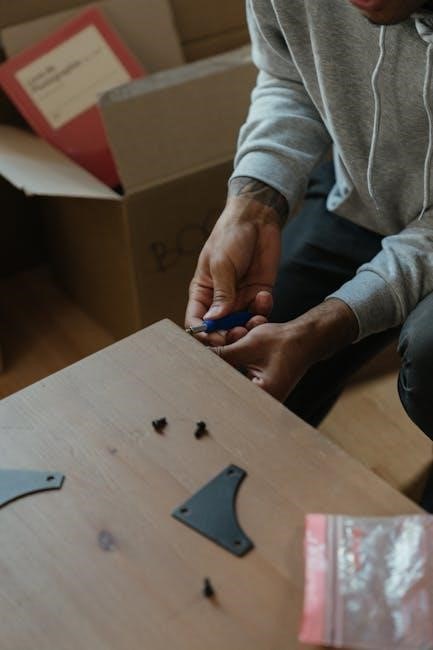Discover the ancient Japanese art of Kumihimo with our comprehensive PDF guide․ Learn essential techniques‚ patterns‚ and step-by-step instructions to create stunning braided jewelry and decorative items․
Overview of Kumihimo and Its Significance
Kumihimo‚ an ancient Japanese braiding technique‚ holds deep cultural and historical significance․ Translating to “gathered threads‚” it involves weaving cords to create intricate‚ textured designs․ Originally used for functional purposes like securing armor‚ Kumihimo evolved into decorative art‚ symbolizing status and spirituality․ Its versatility allows for both traditional and modern applications‚ from jewelry to home decor․ This timeless craft bridges past and present‚ offering a creative outlet for artisans worldwide while preserving its rich heritage․
Understanding the Basics of Kumihimo Braiding
Mastering Kumihimo begins with understanding its fundamental techniques․ This ancient Japanese art involves braiding threads or cords to create intricate designs․ Essential steps include setting up the Kumihimo disk‚ arranging threads‚ and maintaining even tension․ Beginners should start with simple flat or round braids‚ gradually progressing to more complex patterns․ Proper thread placement and consistent movement are key to achieving professional results․ With practice‚ you can unlock the full potential of this versatile and rewarding craft․
Why Use a Kumihimo Instructions PDF?
A Kumihimo Instructions PDF is an invaluable resource for crafters‚ offering clear‚ step-by-step guides and visual aids․ It provides structured learning‚ making it easy to follow complex techniques․ The PDF format ensures accessibility across devices‚ allowing you to practice anywhere․ Whether you’re a beginner or an experienced crafter‚ a comprehensive guide enhances your skills and creativity․ It’s an essential tool for mastering this ancient Japanese braiding art with precision and confidence․

History of Kumihimo
Kumihimo‚ an ancient Japanese braiding art‚ dates back to 645 A․D․ Originally used for functional purposes like securing samurai armor‚ it evolved into a decorative craft over centuries․
Origins of Kumihimo in Japan
Kumihimo‚ meaning “gathering threads‚” originated in Japan around 645 A․D․ This ancient braiding technique was initially used for practical purposes‚ such as securing samurai armor and sword hilts․ Over time‚ it evolved into a decorative art form‚ with intricate patterns reflecting Japanese culture․ The early history is somewhat obscure due to the perishable nature of materials and the secrecy surrounding techniques․ Despite this‚ Kumihimo remains a symbol of Japanese craftsmanship and tradition‚ cherished for its beauty and historical significance․
Historical Use of Kumihimo in Japanese Culture
Kumihimo played a vital role in Japanese history‚ dating back to 645 A․D․ Samurai used it to secure their armor during the Muromachi Period (1333-1573 A․D․)‚ requiring approximately 900 feet of braid․ Beyond practicality‚ Kumihimo became a decorative art‚ adorning traditional clothing and ceremonial items․ Its intricate patterns symbolized status and aesthetic values‚ reflecting Japan’s rich cultural heritage․ This ancient technique transitioned from functional to ornamental‚ preserving its significance in Japanese tradition and artistry over centuries․
Evolution of Kumihimo Techniques Over Time
Kumihimo techniques have evolved significantly since its origins in 645 A․D․ Initially used for functional purposes like securing samurai armor‚ the craft transitioned into decorative art during the Edo period․ Traditional patterns were closely guarded secrets until they were documented 400 years later․ Modern innovations‚ such as the use of beads and contemporary materials‚ have expanded its creative possibilities․ Today‚ Kumihimo bridges ancient traditions with modern design‚ offering endless possibilities for jewelry and textiles while preserving its historical essence․

Basic Supplies for Kumihimo
Essential Kumihimo supplies include a Kumihimo disk‚ embroidery thread‚ scissors‚ and optional beads for decoration․ These tools provide the foundation for creating intricate braids with precision and creativity․
Essential Tools: Kumihimo Disk and Loom
The Kumihimo disk is a circular tool with numbered slots‚ used to organize threads for braiding․ Traditional Marudai looms are also used but less commonly․ The disk is portable and ideal for beginners‚ while the loom offers precision for complex designs․ Both tools help create consistent tension and patterns․ The disk is typically made of foam or cardboard‚ with slots to hold threads in place․ Modern alternatives‚ like small handheld looms‚ combine tradition with convenience for crafters․ These tools are indispensable for mastering Kumihimo techniques․
Choosing the Right Threads and Materials
Selecting the appropriate threads and materials is crucial for successful Kumihimo projects․ Popular choices include embroidery floss‚ yarn‚ and silk threads‚ which vary in thickness and texture․ Beads can also be incorporated for added detail and complexity․ The material choice depends on the desired durability‚ texture‚ and aesthetic appeal of the final piece․ Embroidery floss is a common choice for beginners due to its ease of use and vibrant color options․ Experimenting with different combinations allows for unique and personalized designs․
Additional Tools for Advanced Techniques
For advanced Kumihimo techniques‚ consider using bobbins or thread weights to manage multiple strands efficiently․ Beading needles and specialized scissors are essential for intricate beadwork․ A tape measure or ruler ensures precise length measurements‚ while a work surface clamp helps maintain tension․ Optional tools like thread cards or spools can organize materials‚ enhancing workflow․ These accessories allow for greater control and creativity‚ enabling complex patterns and professional finishes in your braiding projects․

Understanding Kumihimo Braiding Tools
Discover the essential tools for Kumihimo braiding‚ including the Kumihimo disk and traditional looms‚ designed to help create intricate flat and round braids with precision and ease․
Kumihimo Disk: Setup and Usage
The Kumihimo disk is a versatile tool essential for creating intricate braids․ To set it up‚ cut 8 strands of thread (2 of each color) and tie a knot at the end․ Place the knot in the center of the disk and divide the cords into pairs‚ sliding each into the slots on either side of the dots․ This setup allows for even tension and precise braiding․ For beginners‚ using a clip to secure the disk to a work surface can help maintain control․ Experiment with different patterns to master both flat and round braids‚ ensuring a professional finish for your jewelry projects․
Marudai and Other Traditional Looms
The Marudai is a traditional Japanese loom used for Kumihimo braiding‚ featuring 32 slots for threads․ It is ideal for creating round braids and intricate designs․ Historically‚ the Marudai was used by artisans to craft high-quality braids for samurai armor and ceremonial items․ Other traditional tools include the Takadai and Ayataki‚ each with unique setups for specific braid types․ These looms require skill and patience but offer unparalleled control over thread tension and pattern complexity‚ making them essential for authentic Kumihimo techniques․
Modern Alternatives for Kumihimo Braiding
Modern tools like the Kumihimo disk and braiding cards offer accessible alternatives to traditional looms․ These portable and affordable options allow crafters to create intricate designs without specialized equipment․ The disk is particularly popular for its simplicity and versatility‚ enabling both flat and round braids․ Additionally‚ DIY setups using cardboard or foam boards provide budget-friendly ways to explore Kumihimo․ Online tutorials and PDF guides further simplify the process‚ making it easier for beginners to master traditional techniques with contemporary tools․

Setting Up Your Kumihimo Disk
Set up your Kumihimo disk by placing the knot in the center‚ dividing cords into pairs‚ and securing them in slots for even tension and proper braiding alignment․
Preparing the Disk for Braiding
Begin by cutting 8 strands of thread‚ each 20 inches long‚ and tying a knot at one end․ Place the knot in the center of the Kumihimo disk․ Divide the strands into pairs and gently slide each pair into the slots on either side of the numbered dots․ Ensure even tension by pulling each strand taut․ This setup allows for a balanced start‚ making the braiding process smoother and more controlled․ Proper preparation ensures your braid will be uniform and professional-looking from the very first stitch․
Arranging Threads on the Disk
After securing the knot‚ divide the strands into pairs and gently slide each pair into the slots on either side of the numbered dots․ For an 8-strand braid‚ place one pair in each slot around the disk‚ ensuring even spacing․ This arrangement allows for a balanced and symmetrical start․ If using multiple colors‚ alternate them evenly for a visually appealing pattern․ Properly arranging the threads is essential for maintaining consistency and achieving a professional-looking braid․
Securing Threads for Even Tension
To ensure even tension‚ tie a knot at the end of the threads and secure it to a stable surface․ This prevents shifting during braiding․ Gently pull each strand to tighten evenly‚ avoiding overtightening‚ which can distort the braid․ Properly securing the threads ensures a balanced and professional finish․ Even tension is key to achieving a smooth‚ consistent braid‚ whether you’re creating jewelry or decorative items․
Basic Kumihimo Braiding Techniques
Master foundational braiding methods like flat and round braids․ Learn to manipulate threads with proper tension and sequence‚ ensuring smooth‚ consistent results for jewelry or decor․
Simple Flat Braid Tutorial
Begin with a simple flat braid‚ perfect for starters․ Cut 8 strands of embroidery floss‚ 2 yards long‚ and secure them at the center of the kumihimo disk․ Arrange strands evenly around the disk‚ ensuring balanced tension․ Start braiding by crossing strands in sequence‚ moving them clockwise or counterclockwise․ Maintain even tension to achieve a smooth‚ flat design․ Once desired length is reached‚ tie a knot and trim excess thread․ This technique forms the basis for more complex patterns‚ allowing you to gradually experiment with intricate designs․
Round Braid: Step-by-Step Guide
Master the round braid‚ a versatile technique for creating tubular designs․ Begin by setting up your kumihimo disk with 8 strands of thread‚ folded in half and knotted at the center․ Arrange strands evenly around the disk‚ ensuring balanced tension․ Start braiding by moving strands in a sequential‚ clockwise or counterclockwise motion‚ crossing over and under to form a tube․ Maintain consistent tension to avoid puckering․ For a polished finish‚ tie a secure knot and trim excess thread․ This method is ideal for bracelets‚ necklaces‚ or decorative cords‚ offering a elegant‚ rounded texture․
Common Mistakes and Troubleshooting
Common errors in kumihimo include uneven tension‚ misaligned threads‚ and incorrect crossing patterns․ To fix uneven tension‚ adjust strands gently while braiding․ If threads become misarranged‚ stop and realign them on the disk․ For pattern errors‚ carefully unravel the braid to the mistake point and re-braid․ Knots that are too tight or loose can be adjusted by gently tugging on the strands․ Practice patience and consistency to master the technique and achieve professional-looking results․

Advanced Kumihimo Techniques
Explore intricate designs with spiral and tubular braids‚ incorporating beads and complex patterns․ Master advanced techniques like color manipulation and multi-layered braiding for stunning‚ professional results․
Spiral Braids: Adding Complexity
Spiral braids introduce a dynamic twist to traditional Kumihimo designs․ To create spiral patterns‚ arrange threads in a specific sequence on the disk‚ ensuring even tension․ Begin by crossing strands in alternating directions‚ then repeat the sequence to form the spiral․ For intricate designs‚ incorporate beads or multiple colors․ Proper thread placement and consistent movement are key to achieving smooth‚ even spirals․ Practice this technique to master complex‚ visually striking braids that elevate your Kumihimo projects to the next level․
Tubular Braids: Incorporating Beads
Tubular braids with beads add dimension and elegance to Kumihimo projects․ Begin by setting up 8-12 threads on the disk‚ alternating colors for visual interest․ Create a base braid‚ then introduce beads by threading them onto specific strands․ For even distribution‚ add beads at consistent intervals‚ ensuring proper tension․ Experiment with bead placement patterns to achieve unique designs․ Secure beads with a small knot or crimp․ This technique is ideal for jewelry‚ offering a professional finish to bracelets‚ necklaces‚ and accessories․
Combining Colors and Patterns
Experiment with vibrant color combinations and intricate patterns to elevate your Kumihimo designs․ Choose harmonious thread colors and arrange them strategically on the disk to achieve desired visual effects․ Alternate thread positions and braiding moves to create dynamic patterns․ Incorporate beads for added texture and interest․ This technique allows for endless creativity‚ enabling crafters to produce unique‚ personalized pieces․ With practice‚ you can master complex designs‚ blending colors and patterns seamlessly to craft stunning jewelry and decorative items․

Kumihimo Patterns and Designs
Explore the world of Kumihimo patterns‚ from traditional Japanese designs to modern creations․ Our PDF guide offers detailed instructions to help crafters implement these designs․
Traditional Japanese Kumihimo Patterns
Traditional Japanese Kumihimo patterns reflect centuries of cultural heritage․ Originating over 1‚300 years ago‚ these designs were often used in samurai armor and ceremonial contexts․ Classic patterns like the “Hitatare” and “Tsuzure” emphasize symmetry and simplicity‚ with symbolic meanings embedded in their structure․ These timeless designs are now adapted into modern jewelry and decor‚ preserving their historical significance while appealing to contemporary tastes․ The PDF guide provides detailed diagrams and step-by-step instructions to recreate these iconic patterns accurately․
Modern Interpretations and Variations
Modern Kumihimo interpretations infuse traditional techniques with contemporary creativity․ Artists explore new materials‚ colors‚ and patterns‚ blending cultural heritage with fresh designs․ Beaded Kumihimo has gained popularity‚ allowing for intricate detailing․ Experimentation with tubular braids and spiral patterns offers versatility․ The PDF guide showcases innovative approaches‚ from minimalist styles to bold‚ vibrant creations․ These modern twists make Kumihimo accessible to crafters of all levels‚ inspiring unique jewelry‚ home decor‚ and fashion accessories that bridge tradition and modernity seamlessly․
Creating Custom Designs
Unleash your creativity by designing unique Kumihimo patterns tailored to your style․ Experiment with diverse thread colors‚ bead placements‚ and braid techniques to craft one-of-a-kind pieces․ The PDF guide provides detailed instructions on how to mix materials and patterns for personalized designs․ Whether it’s jewelry‚ accessories‚ or home decor‚ customize every detail to reflect your artistic vision․ This flexibility allows you to create truly original pieces that stand out‚ blending tradition with modern flair effortlessly․

Incorporating Beads into Kumihimo
Enhance your Kumihimo creations by seamlessly integrating beads for added beauty and complexity․ The PDF guide offers detailed instructions on basic and advanced bead placement techniques‚ ensuring professional results in your jewelry projects․
Beaded Kumihimo: Basic Techniques
Master the fundamentals of incorporating beads into your Kumihimo projects with clear‚ step-by-step instructions․ Begin by setting up your Kumihimo disk and threading beads onto your strands․ For a basic tubular braid‚ start by creating a few laps without beads to establish a stable foundation․ Once secure‚ introduce beads into your design by carefully placing them within the braid pattern․ Ensure even tension and alignment for a polished look․ Practice these techniques to achieve professional-quality beaded Kumihimo jewelry and decorative items․
Advanced Bead Placement Strategies
Elevate your Kumihimo creations with sophisticated bead placement techniques․ Experiment with intricate patterns by strategically positioning beads within your braid to create visually striking designs․ Use variations in bead size‚ shape‚ and color to add depth and texture․ For tubular braids‚ incorporate beads at specific intervals to form complex motifs․ Advanced strategies include alternating bead placement‚ spiral patterns‚ and integrating multiple bead types for a dynamic effect․ Practice these methods to achieve intricate‚ professional-quality Kumihimo designs with flawless bead integration․
Fixing Bead Placement Errors
Correcting bead placement mistakes in Kumihimo requires patience and attention to detail․ If beads are misplaced‚ gently remove them by reversing the braiding steps or carefully cutting the thread․ Re-thread the bead and re-braid‚ ensuring proper tension to maintain the design․ For intricate patterns‚ use a needle to guide beads into place․ Regularly inspect your work to catch errors early‚ as fixing mistakes becomes more challenging as the braid progresses․ Practice and experience will improve your ability to correct bead placement seamlessly․

Kumihimo Projects for Beginners
Start with simple Kumihimo projects like bracelets or necklaces using embroidery floss and a disk․ These easy-to-follow designs are perfect for learning basic braiding techniques and building confidence․
Simple Kumihimo Bracelet Tutorial
Begin your Kumihimo journey with a simple bracelet using a Kumihimo disk and embroidery floss․ Cut 8 strands‚ 2 of each color‚ and tie a knot at the end․ Place the knot in the disk’s center and divide the cords into pairs‚ securing them in slots․ Follow basic braiding steps‚ moving strands clockwise and counterclockwise to create a flat braid․ Secure the ends with a bead or knot․ Trim excess thread for a polished finish․ This project is perfect for mastering foundational techniques while creating a wearable accessory․
Creating a Kumihimo Necklace
Elevate your Kumihimo skills by crafting a stunning necklace․ Start by cutting 8 strands of thread‚ folding them in half‚ and securing with a knot․ Thread the strands through the Kumihimo disk‚ arranging them evenly around the slots․ Braid using a simple flat or round pattern‚ incorporating beads for added elegance․ Once the desired length is achieved‚ tie off the ends and attach a clasp or tassel․ Customize with vibrant thread colors or intricate bead placements to create a unique‚ eye-catching accessory perfect for any occasion․
Other Creative Kumihimo Applications
Explore beyond jewelry with Kumihimo! Use braids to create decorative home accents‚ such as wall hangings or coasters․ Craft functional items like keychains‚ bag charms‚ or hair ties․ Incorporate Kumihimo into clothing by adding braided trims or belts․ Experiment with blending beads and threads for unique zipper pulls or embellishments․ The versatility of Kumihimo allows for endless creativity‚ making it a versatile craft for both practical and artistic projects․ Let your imagination shine by adapting this ancient technique to modern-day applications!

Resources for Kumihimo Enthusiasts
Find free Kumihimo guides‚ online communities‚ and books․ Explore tutorials‚ patterns‚ and expert tips to enhance your braiding skills and stay inspired for new projects․
Free Kumihimo PDF Guides
Access a wealth of free Kumihimo PDF guides online‚ offering step-by-step instructions for various braiding techniques․ From simple flat braids to intricate bead-filled designs‚ these guides provide detailed patterns and tutorials․ Websites like Beading Daily and Interweave offer downloadable resources‚ perfect for beginners and advanced crafters alike․ Explore comprehensive guides like the Spiral 12 Warp Kumihimo Bracelet Instructions or the Kumihimo Braiding: A Comprehensive Guide to master the craft․ These free resources are invaluable for improving your skills and exploring new projects;
Online Communities and Forums
Join vibrant online communities and forums dedicated to Kumihimo enthusiasts․ Platforms like Beading Daily and specialized Facebook groups offer tutorials‚ tips‚ and project ideas․ Engage with fellow crafters‚ share your work‚ and learn from experts․ These forums are invaluable for troubleshooting techniques‚ discovering new patterns‚ and staying updated on trends․ Participate in discussions to refine your skills and gain inspiration for your next Kumihimo project․
Recommended Books and Tutorials
Enhance your Kumihimo skills with highly recommended books and tutorials․ Titles like Kumihimo Braiding: A Comprehensive Guide offer in-depth instructions for mastering traditional and modern techniques․ Online tutorials provide step-by-step videos and photos‚ making complex braids accessible․ Expert authors share insights on materials‚ tools‚ and patterns‚ ensuring a smooth learning curve․ These resources are perfect for both beginners and advanced braiders‚ offering inspiration and practical guidance to refine your craft and create intricate designs with confidence․
Mastering Kumihimo is a rewarding journey‚ and with the right instructions‚ you can create stunning‚ intricate designs․ This guide provides a comprehensive path to excellence‚ ensuring you enjoy every step of braiding and crafting beautiful pieces with confidence and creativity․
Final Tips for Mastering Kumihimo
Consistency and patience are key to mastering Kumihimo․ Always ensure proper thread tension and disk setup for even braiding․ Practice simple patterns before advancing to complex designs․ Experiment with colors and materials to create unique pieces․ Refer to detailed Kumihimo instructions PDF guides for troubleshooting common mistakes․ Join online communities for inspiration and tips․ With dedication and creativity‚ you’ll unlock the full potential of this ancient Japanese braiding art‚ crafting stunning jewelry and decorative items with confidence․
Encouragement to Experiment and Share
Embrace creativity and explore the endless possibilities of Kumihimo! Experiment with diverse colors‚ patterns‚ and materials to develop your unique style․ Share your creations with fellow enthusiasts through online communities and forums‚ gaining inspiration and feedback․ Teaching others or showcasing your work can deepen your understanding and passion for this traditional Japanese art․ Don’t hesitate to try new techniques—every braid tells a story‚ and every mistake is a stepping stone to mastery․ Happy braiding!
